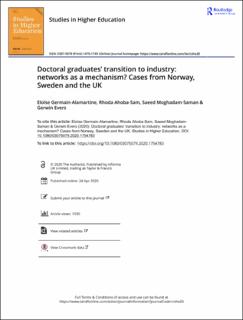| dc.contributor.author | Germain-Alamartine, Eloïse | |
| dc.contributor.author | Ahoba-Sam, Rhoda | |
| dc.contributor.author | Moghadam Saman, Saeed | |
| dc.contributor.author | Evers, Gerwin | |
| dc.date.accessioned | 2021-05-10T14:01:22Z | |
| dc.date.available | 2021-05-10T14:01:22Z | |
| dc.date.created | 2020-11-12T08:41:59Z | |
| dc.date.issued | 2020-04 | |
| dc.identifier.citation | Germain-Alamartine, E., Ahoba-Sam, R., Moghadam Saman, S., Evers, G. (2020) Doctoral graduates’ transition to industry: networks as a mechanism? Cases from Norway, Sweden and the UK. Studies in Higher Education, DOI: 10.1080/03075079.2020.1754783. | en_US |
| dc.identifier.issn | 0307-5079 | |
| dc.identifier.uri | https://hdl.handle.net/11250/2754738 | |
| dc.description.abstract | Increased public investment in PhD education to drive innovation has led to a recent rapid growth in the number of PhD graduates. Academic labour markets have not developed at the same pace. An ever-larger share of the graduates is finding employment in industry. The transition from academia to industry is not always easy. The present study aims to provide insights into the role played by PhDs’ networks in the job search after graduation. Our data comprise interviews with industry-employed doctoral graduates in STEM disciplines from Sweden, Norway and the UK. Our findings show that PhDs’ autonomously built personal networks can help match their specific scientific expertise with labour market demands. We distinguish country-specific patterns and characteristics of the transition, in which regional career paths are more (Scandinavia) or less (the UK) noticeable. The study has practical implications, in particular for PhD students and graduates, related to their career orientation. | en_US |
| dc.language.iso | eng | en_US |
| dc.publisher | Informa UK Ltd. (Taylor & Francis) | en_US |
| dc.rights | Attribution-NonCommercial-NoDerivatives 4.0 Internasjonal | * |
| dc.rights.uri | http://creativecommons.org/licenses/by-nc-nd/4.0/deed.no | * |
| dc.subject | høyere utdanning | en_US |
| dc.subject | PhD-utdanning | en_US |
| dc.subject | stipendiater | en_US |
| dc.title | Doctoral graduates’ transition to industry: networks as a mechanism? Cases from Norway, Sweden and the UK | en_US |
| dc.type | Peer reviewed | en_US |
| dc.type | Journal article | en_US |
| dc.description.version | publishedVersion | en_US |
| dc.rights.holder | © 2020 The Author(s). | en_US |
| dc.subject.nsi | VDP::Samfunnsvitenskap: 200::Pedagogiske fag: 280 | en_US |
| dc.source.pagenumber | 16 | en_US |
| dc.source.journal | Studies in Higher Education | en_US |
| dc.identifier.doi | 10.1080/03075079.2020.1754783 | |
| dc.identifier.cristin | 1847214 | |
| dc.relation.project | EC/H2020/722295 | en_US |
| cristin.ispublished | true | |
| cristin.fulltext | original | |
| cristin.qualitycode | 2 | |

